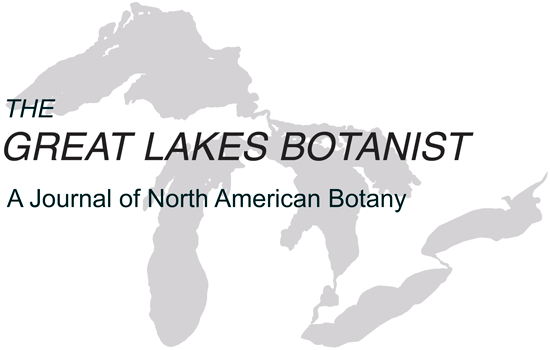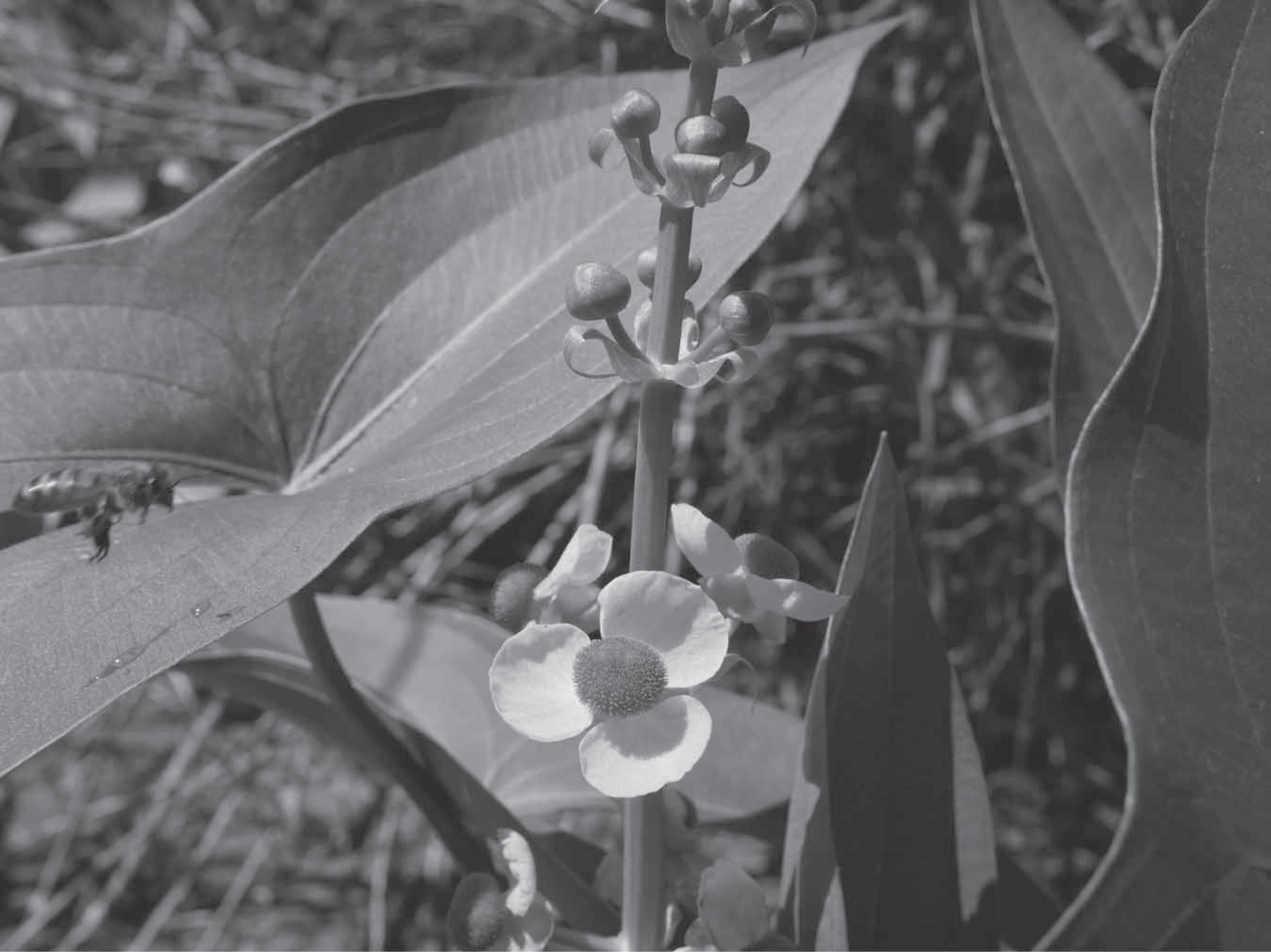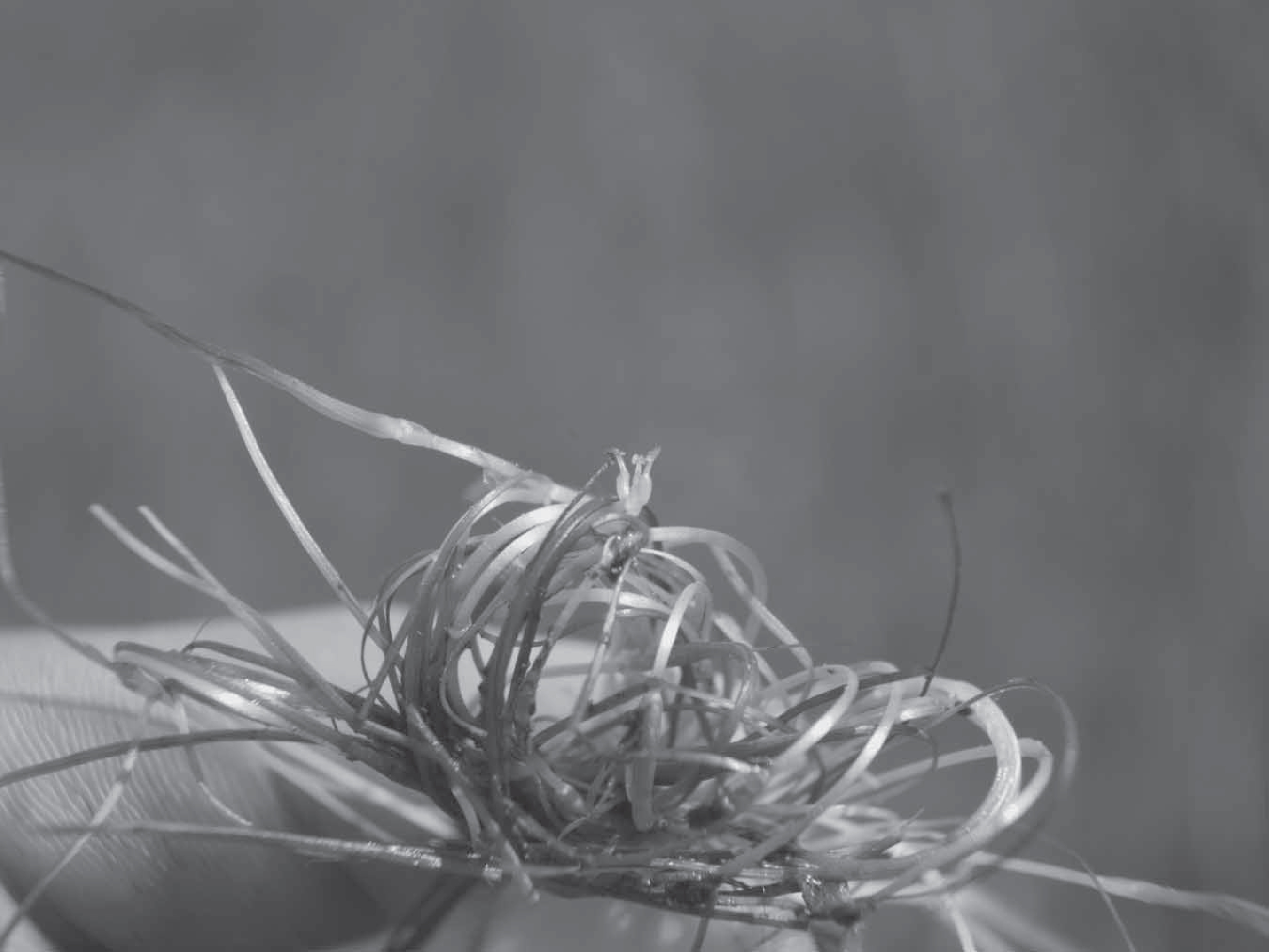The following two species were discovered during a floristic inventory of a portion of the Galien River Marsh in southwestern Berrien County, Michigan. Both species occupied habitat along the south bank of the Galien River in an area where dense stands of the invasive Phalaris arundinacea L. (reed canary grass) were treated with herbicide beginning in 2016. High water levels in 2018–2021 resulted in the development of submergent marsh in this area.
Sagittaria brevirostra Mack. & Bush
Alismataceae
Short-beaked Arrowhead
Significance of the Report. The first collection in the state of Michigan since 1861
Previous Knowledge. Sagittaria brevirostra Mack. & Bush, commonly called short-beaked arrowhead (Figure 1), is an aquatic, emersed perennial that grows in ponds, marshes, lakes, and streams or riverbanks (Haynes and Hellquist 2000a). It is concentrated in eastern Nebraska, eastern Kansas, Iowa, Missouri, and Illinois, with scattered occurrences extending as far as Colorado, New Mexico, Minnesota, Virginia, and Alabama (Kartesz 2015). It is considered a species of conservation concern in Colorado, Illinois, Michigan, Minnesota, Tennessee, and Virginia (NatureServe 2022). Charles Deam stated that S. brevirostra was “probably our most common species” of Sagittaria in Indiana with collections as far north as Lake and St. Joseph Counties (Deam 1940; Wilhelm and Rericha 2017). It has been frequently collected in northeast Illinois with collections in every county except for Lake County (Wilhelm and Rericha 2017). Prior to this report, S. brevirostra was presumed extirpated (SX) in Michigan with a state status of Special Concern (SC) (Michigan Natural Features Inventory 2021). There have been two historical collections in Michigan, one from Jackson County in 1838 [Wright, MICH1282220] and one from Washtenaw County in 1861 [Almendinger, MICH1282221].
Discussion. On July 26, 2021, three individuals of Sagittaria brevirostra were observed growing approximately 15 meters west of the Galien River County Park boardwalk on the south side of a sandbar adjacent to the Galien River. None of the individuals had fully mature fruit or flowers. The population was revisited by the first author and botanist Nate Scheerer on September 6, 2021, when three additional individuals were observed closer to the boardwalk on the southeast side of the sand bar. These individuals were in full flower, and one bore mature fruit. Sagittaria brevirostra might have previously been overlooked at the site due to its scattered presence within a large population of the very similar Sagittaria latifolia Willd. (common arrowhead).
Diagnostic Characters. Twenty-four species of Sagittaria are recognized in North America north of Mexico (Haynes and Hellquist 2000a), seven of which are documented in Michigan (Voss and Reznicek 2012). Sagittaria brevirostra is differentiated morphologically from other North American species of Sagittaria by the following combination of characters: long lower bracts (often more than 1.5 cm long) which are distinct or fused less than ¼ of their lengths; sagittate leaves; beaks of the achenes 0.4–0.7 mm long; and glabrous filaments (Haynes and Hellquist 2000a; Voss and Reznicek 2012; Wilhelm and Rericha 2017).
Specimen Citation. MICHIGAN. Berrien Co.: City of New Buffalo. 41.80881, –86.719269. Material collected on the edge of a sand bar adjacent to the Galien River. Three individuals were growing with Sagittaria latifolia, with the latter being dense throughout the sand bar. Associated species: Cyperus odoratus, Cyperus strigosus, Ludwigia palustris, Lycopus americanus, Lythrum salicaria, Penthorum sedoides, and Rosa palustris. July 26, 2021, Pilla and Engel NJP.2107.2602.p. (MICH).
Zannichellia palustris L.
Potamogetonaceae
horned pondweed
Significance of the Report. First collection from southwestern Lower Michigan.
Previous Knowledge. Zannichellia palustris L., commonly called horned pondweed (Figure 2), is an aquatic, submersed perennial that grows in alkaline, brackish, and freshwater streams and lakes (Haynes and Hellquist 2000b; Crow and Hellquist 2006). It has a worldwide distribution (Haynes and Hellquist 2000b). Within the eastern United States, Z. palustris appears to be local with several clustered areas of occurrence (Kartesz 2015). In Michigan, Z. palustris was historically known from several counties in southeastern Lower Michigan, one historical record from the Saginaw Bay region, and scattered counties on the northern Lake Michigan shoreline in northern Lower and eastern Upper Michigan (MICHIGAN FLORA ONLINE 2011).
Discussion. The Zannichellia palustris population was observed on July 26, 2021, scattered on sandy substrates in 15–20 cm of water in small drainage channels behind fresh alluvial deposits along the Galien River. The population was scattered in these channels. This collection is the first documented report of this species for Berrien County. A 2020 collection (not seen by us) from Kalamazoo County and deposited in the Michigan State University Herbarium (MSC) is reported in Cole-Wick et al. (2021). Together, these collections represent the first records from southwestern Lower Michigan. Surveys for additional populations of Zannichellia palustris are recommended to better understand its distribution and abundance in Michigan.
Diagnostic Characters. Zannichellia palustris is superficially similar to other submergent, thin-leaved aquatic plants, especially those in the Potamogetonaceae. Zannichellia can be identified by its lack of floating leaves; opposite to whorled submergent, entire leaves; single seeded fruits; and axillary, submergent inflorescences (Haynes and Hellquist 2000b; Crow and Hellquist 2006; Voss and Reznicek 2012).
Specimen Citation. Zannichellia palustris L. MICHIGAN. Berrien Co.: City of New Buffalo. 41.808663, –86.720177. Material collected from a small dense stand in shallow sandy soil of the Great Lakes Marsh within about 6” of water. Dense floating algae could pose a threat. Locally common in areas of flowing water. Associated species: Ceratophyllum demersum, Lemna turionifera, Ludwigia palustris, Potamogeton crispus, Potamogeton foliosus, Spirodela polyrhiza, Wolffia borealis, and Wolffia columbiana. July 26, 2021, Pilla and Engel NJP.2107.2601.p. (MICH).
Acknowledgments
We thank Mitch Alix, Purdue University Northwest, for confirming the identity of Sagittaria brevirostra. Tyler Bassett, Ashley Cole-Wick, Erik Elgin, and Elizabeth Haber, Michigan Natural Features Inventory, for their willingness to share their data and knowledge on distribution and collection, Nathaniel Scheerer for providing assistance in data collection, and Bradford Slaughter, Orbis Environmental Consulting, for providing constructive comments on the formation of the manuscript.
Literature Cited
Cole-Wick, A. A., T. J. Bassett, E. L. Elgin, and P. J. Higman. (2021). Surveys of aquatic macrophytes at Fort Custer Training Center. MNFI Report No. 2021-11. Michigan Natural Features Inventory, Michigan State University Extension, Lansing.
Crow, G. E., and C. B. Hellquist. (2006). Aquatic and wetland plants of northeastern North America, Volume 2. Angiosperms: Monocotyledons. University of Wisconsin Press, Madison.
Deam, C. C. (1940). Flora of Indiana. Department of Conservation, Indianapolis, Indiana.
Haynes, R. R., and C. B. Hellquist. (2000a). Sagittaria. Pp. 11–23 in Flora of North America, Volume 22: Magnoliophyta: Alismatidae, Arecidae, Commelinidae (in part), and Zingiberidae. Flora of North America Editorial Committee, editors. Oxford University Press, New York, N.Y.
Haynes, R. R., and C. B. Hellquist. (2000b). Zannichellia. Pp. 84–85 in Flora of North America, Volume 22: Magnoliophyta: Alismatidae, Arecidae, Commelinidae (in part), and Zingiberidae. Flora of North America Editorial Committee, editors. Oxford University Press, New York, N.Y.
Kartesz, J. T. (2015). The Biota of North America Program (BONAP). North American Plant Atlas. Chapel Hill, N.C. [maps generated from Kartesz, J.T. 2015. Floristic Synthesis of North America, Version 1.0. Biota of North America Program (BONAP). (in press)]. Available at http://bonap.net/napa (Accessed December 19, 2021).http://bonap.net/napa
MICHIGAN FLORA ONLINE. Reznicek, A. A., E. G. Voss, and B. S. Walters. (2011). University of Michigan. Available at http://michiganflora.net/home.aspx. (Accessed December 19, 2021).http://michiganflora.net/home.aspx
Michigan Natural Features Inventory. (2021). Sagittaria brevirostra (short-beaked arrowhead). Michigan State University, MSU Extension, Lansing, Michigan. Web. Available at https://mnfi.anr.msu.edu/species/description/15091/Sagittaria-brevirostra. (Accessed December 19, 2021).https://mnfi.anr.msu.edu/species/description/15091/Sagittaria-brevirostra
NatureServe. (2022). NatureServe Network Biodiversity Location Data accessed through NatureServe Explorer [web application]. NatureServe, Arlington, Virginia. Available at https://explorer.natureserve.org/. (Accessed September 27, 2022).https://explorer.natureserve.org/
Voss, E. G., and A. A. Reznicek. (2012). Field manual of Michigan flora. University of Michigan Press, Ann Arbor.
Wilhelm, G., and L. Rericha. (2017). Flora of the Chicago region: A floristic and ecological synthesis. Indiana Academy of Science, Indianapolis.



